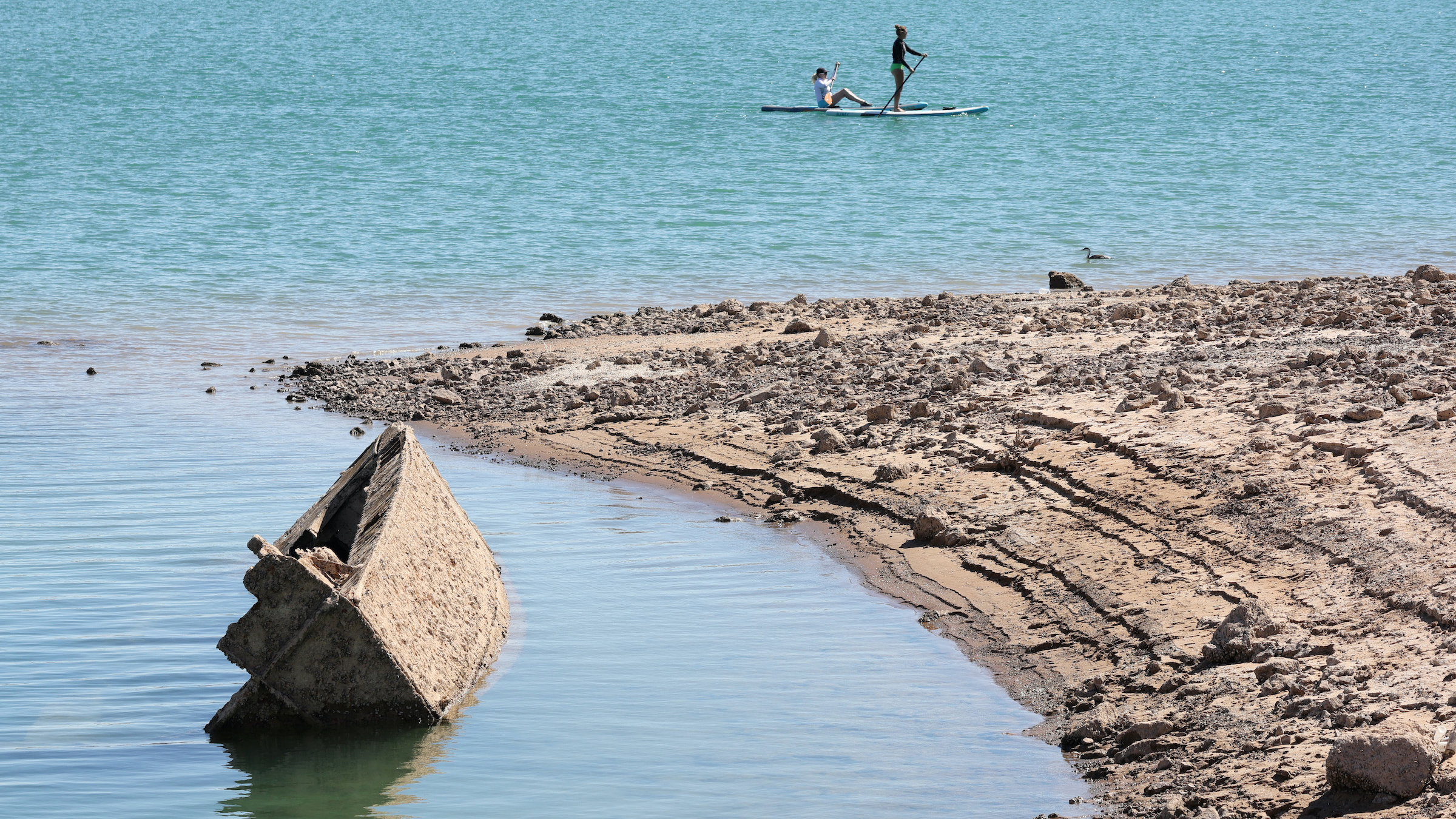Lake Mead dwindles, and a WWII-era 'swamp boat' emerges
"Higgins boats" are famous for their use on D-Day in 1944.

A World War II landing craft — the same type famous for its use on D-Day in 1944 — is the latest object to emerge from the declining waters of Lake Mead near Las Vegas.
Scientists say the lake's level is at a record low, largely because of a long-term drought across the American Southwest — but human-induced climate change may be making the drought worse.
The falling waters have revealed several objects before now, including sunken boats and human corpses, as Live Science previously reported. In one case, the deceased individual appears to have died from a gunshot wound before the body was bundled into a barrel and sunk, leading to speculation it may have been a mob-related killing, CBS News reported.
The latest revelation from Lake Mead's receding waters is a World War II-era landing craft known as a "Higgins boat," a mostly-plywood vessel based on American swamp boats.
Related: Japanese submarine, sunk in WWII and later bombed by salvager, is VR ready
More than 23,000 Higgins boats were built during the 1940s for the U.S. and Allied militaries, to carry soldiers and fighting vehicles from ships to shore, according to Stanford University.
The most famous moment for these iconic boats was on D-Day on June 6, 1944, when around 1,500 Higgins boats carried American, British and Canadian troops to beaches in Normandy in France while under heavy fire from occupying German forces.
Get the world’s most fascinating discoveries delivered straight to your inbox.
War surplus
According to the Las Vegas Review-Journal, the Higgins boat at Lake Mead was surplus to the war effort and was sold off by the military in the years after World War II.
The vessel was then used in surveys of the Colorado River, but it was later sold to a marina at Lake Mead; eventually, it was deliberately sunk to anchor a breakwater — an offshore structure built to protect a marine area from waves — at a depth of nearly 185 feet (56 meters).
Local dive operators then included the sunken wreck on tours, and staff from the National Parks Service began diving on the site in 2006 to remove its engine, the report said.
"The surplus nature of the craft highlights an earlier era of the lake when Las Vegas and Lake Mead were much more remote and removed from much of the United States, where relatively inexpensive WWII surplus could be pressed into duty for new peaceful purposes in the park," NPS officials said in an email to the newspaper.
Boatbuilder Andrew Higgins of New Orleans designed the Higgins boat in the late 1930s for the U.S. military, using innovations he'd developed for swamp boats.
The vessel could carry a 36-man platoon or a jeep and a 12-man squad at a speed of up to 12 knots (13.8 mph, or 22.2 km/h); and a key to its design was a "spoonbill bow" below the front ramp that forced water underneath and allowed the vessel to push up onto shore, according to Smithsonian magazine.
Such was its impact on D-Day and in other naval operations of World War II that great credit was given to its designer by U.S. officials at the highest levels of government: "Andrew Higgins is the man who won the war for us," President Dwight Eisenhower told an interviewer in 1964.
Related: Wreck of famous British sub sunk by Germans in WWII discovered off Malta
Falling waters
Lake Mead is a reservoir formed by the Hoover Dam on the Colorado River, on the border of Arizona and Nevada about 25 miles (40 km) east of Las Vegas. Construction of the dam began in 1931 and by 1938 the rising lake waters had forced the evacuation of several towns.
Measurements by US Bureau of Reclamation (USBR) show that the water in Lake Mead reached its highest point of about 1,220 feet (372 m) above sea level in 1941, 1983 and 1997, but fell by up to 200 feet (61 m) in the periods between those dates.
It's the largest reservoir by volume in the United States (although Lake Powell, a reservoir upstream on the Colorado River between Arizona and Utah, is more spread out) and provides water to millions of people in Arizona, California and Nevada, according to the NPS.
But the entire Southwest has been suffering a severe drought since the late 1990s, and the water level at Lake Mead has fallen dramatically. It's now at about 1,040 feet (317 m) above sea level, and the lake is estimated to be only about 27% full, the USBR reports.
Geophysicist Richard Seager of the Lamont-Doherty Earth Observatory at Columbia University in New York told Live Science that the decades-long drought at Lake Mead is mainly the result of a persistent "cold phase" in weather of the tropical Pacific Ocean region that causes relatively dry conditions over the Southwest of the United States.
Lake Mead had reached its highest levels during a warm phase of the same weather oscillation in the 1980s and 1990s, but the peak of an earlier cold phase resulted in the "Dust Bowl" droughts of the 1930s — one of the worst natural disasters in the United States, according to the National Drought Mitigation Center of the University of Nebraska-Lincoln.
But Seager also noted that rising levels of greenhouse gases, such as the carbon dioxide released by burning fossil fuels, may be making the current natural drought much worse. "According to all our models, that also reduces precipitation [rainfall] over the southern part of the Southwest in winter and in spring," he said. "That appears to already be happening."
Global warming could also cause more water to evaporate from the surface of the lake, leaving less to run off into streams, he said.
For now, it seems the weather in the region is stuck in the cold and dry phase of its long-term pattern, and the drought situation is not likely to get better until that changes, he said.
But "the fact that human-induced climate change reduces winter and spring precipitation in the southern part of Southwest, that is going to continue," he said. "It would take a miraculous swing in natural variability to return matters back to where they were in the 80s and 90s."
Originally published on Live Science.
Tom Metcalfe is a freelance journalist and regular Live Science contributor who is based in London in the United Kingdom. Tom writes mainly about science, space, archaeology, the Earth and the oceans. He has also written for the BBC, NBC News, National Geographic, Scientific American, Air & Space, and many others.

